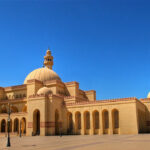Yaqusa.
After the battle of Ajnadein, the Muslims broke the camp at Ajnadein in the first week of August 634 C.E. and set out for Damascus. The advance of the Muslims was resisted by a Byzantine force at Yaqusa on the bank of the Yermuk. The Byzantine force was defeated with considerable loss and Muslims pushed on towards their objective Damascus.
Marj-us-Saffar.
After three days march from Yaqusa, the Muslim forces arrived at Marj-us-Saffar, twelve miles from Damascus, and here their way was barred by a Byzantine force. The battle began on the 19th August with personal duels.
In these duels the Muslim cavaliers won and their Byzantine counterparts lost their lives. When after the personal combats, the battle began, the Byzantines stood firm for a few hours, but as the Muslims increased their pressure, the Byzantine forces withdrew. Two Byzantine Generals, Kulus and Azazeer were captured alive. Many Byzantine soldiers were killed. The survivors withdrew post haste to Damascus.
Gibbon.
In his well-known work Decline and Fall of the Romau Empire, Gibbon has a passage giving a graphic description of the arrival of the Muslim forces at Damascus.
He writes; “The sad tidings of the fall of Ajnadein were carried to Damascus by the speed of grief and terror, and the inhabitants beheld from the walls of the city the return of the Muslim heroes of Ajnadein Amr bin Al ‘Aas led the van at the head of nine thousand horse, the bands of the Muslims followed each other in formidable review; and the rear was closed by Khalid in person, with the standard of the black eagle.
To the activity of Zarrar, he entrusted the commission of patrolling round the city with two thousand horses, of scouring the plain and of intercepting all succor or intelligence. The rest of the Arabian chiefs were fixed in their respective stations before the seven gates of Damascus and the siege was renewed with vigor and confidence.”
Byzantine garrison.
The Byzantine garrison in Damascus was commanded by Thomas, a son-in-law of the Byzantine emperor Heraclius. At the principal gate of the city, the Byzantines erected a lofty crucifix before which prayers were offered that the Son of God would defend his servants and vindicate his truth.
The siege.
The siege of Damascus began on the 21st of August, and on the 23rd of August 634 C.E., Abu Bakr was dead. Damascus fell in the hands of the Muslims in September 634 C.E. during the caliphate of Umar.
Visits: 0






